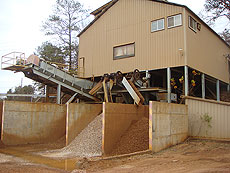NOvA detector to sit under uniquely protective roof
 |
| New Riverside Ochre company separates barite of different qualties at its barite processing mill. |
The NOvA facility under construction in Ash River, Minn., will shield a large, sensitive neutrino detector from distracting subatomic particles such as cosmic rays that rain on the Earth from space.
The NOvA collaboration found one important piece of its armor in the red clay of Georgia. In October 2009, the laboratory used about $400,000 in American Recovery and Reinvestment Act funds to purchase and transport about 1,200 tons of barite, a dense type of rock, from New Riverside Ochre Company Inc. in Cartersville, Ga.
The collaboration will install a six-inch layer of barite, which is 60 percent heavier than a six-inch layer of common granite, on the roof of the detector building. This unique set of shingles "will do the same job as about 4 feet of concrete," said geologist Stan Bearden, vice president of operations for New Riverside Ochre Company.
Barite is most commonly used in a muddy type of drilling fluid that miners pump into boreholes to prevent the sudden release of pressure while drilling for oil or gas. It is also used in products as varied as brake pads, glass, tennis balls and refrigerator magnets.
But Fermilab is most interested in its ability to interact with cosmic rays. If a cosmic ray were to penetrate unseen into the NOvA detector and bump into a particle in the liquid scintillator inside, it could result in a shower of particles, which could be mistaken for an interaction caused by a neutrino. If the cosmic rays interact with the barite on the roof instead, the resulting particles will shower at the edge of the NOvA detector and will be easier to classify as the result of a cosmic ray, not a neutrino.
New Riverside Ochre Company is family-owned; current owner Jim Dellinger's grandfather, William Satterfield, founded it in 1905. It now has 31 employees and is the leading producer of high-grade barite and natural iron-oxide pigments in the United States.
The company managed to complete the order in about one month. Now the rock is waiting in storage in Virginia, Minn., to take its protective place next fall.
-- Kathryn Grim
|